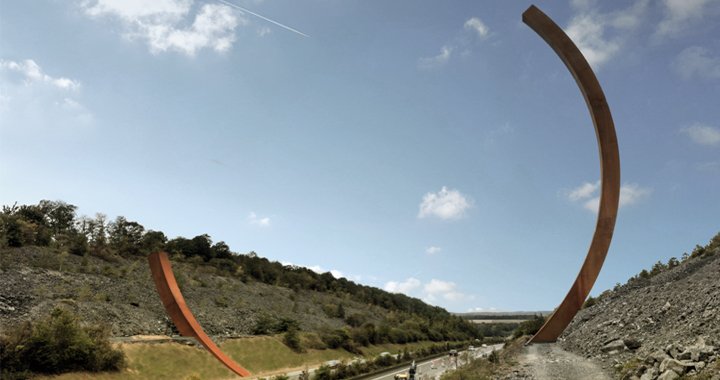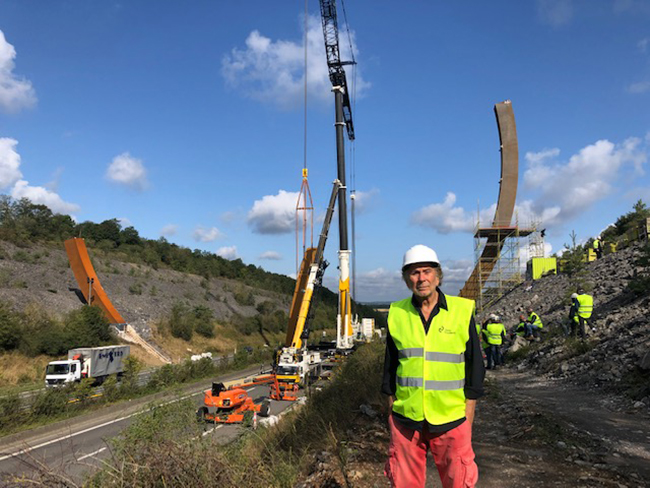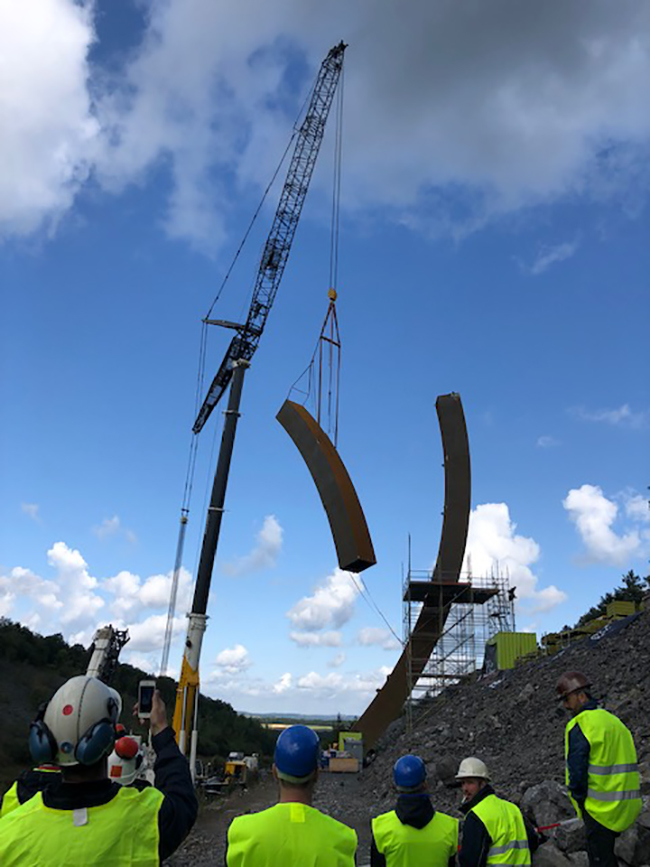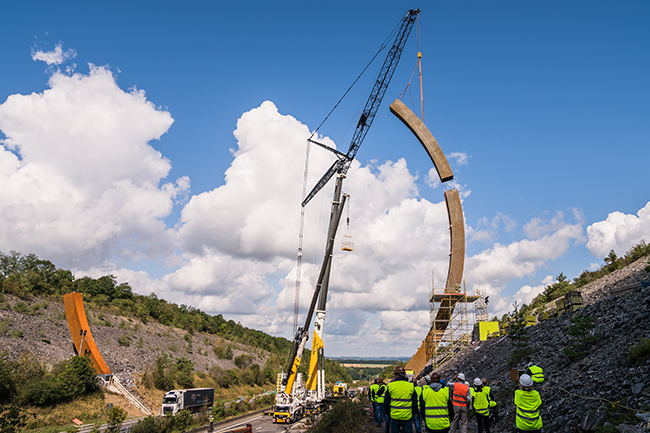
Arc Majeur. The radicality of the new composition
French sculptor Bernar Venet’s monumental sculpture, Arc Majeur, will open on the 99th kilometre of Belgium’s E411 motorway on October 23
08/10/2019
‘It's not the size that matters to me, it's the process of creation itself. The radicality of the new composition. (...) I have a theory about working in art. There should be a heroic aspect in the process of creation. The first is, of course, the radicality of the idea. If you think of Malevich, it was extremely heroic of him to imagine, in the 1910s and 1930s, doing something that was totally impossible for people to understand. And, in a sense, quite impossible for the artist himself to comprehend, too. Because you don't know where you are going when you do something like this. You have no idea if people are going to follow you and one day understand if what you are doing is important and will be appreciated in the future. So, that's one thing – the radicality of the idea. The second is when you do art that shows that you have invested yourself completely and put all your energy into it. You do art because this is what you are supposed to do. And you do it,’ is what French sculptor Bernar Venet told me in the summer of 2016, when we met at his ‘Gesamtkunstwerk’, the Venet Foundation in the town of Le Muy in the south of France. A few days earlier, he had created in one of the Foundation's gallery rooms a new version of his work Effondrement: 200 Tones, 2015. With just the aid of two assistants, Venet had lifted a total of two hundred tonnes of iron bars/arcs and allowed them to tumble into a new arrangement via a randomly-driven fall, sliding over each other so that their final position is even more aggressive, chaotic and unpredictable.
Photo: Courtesy of Bernar Venet Studio
The line, in all of its mathematical and physical manifestations, has been central to Bernar Venet’s work since 1976. He has always been intrigued by the challenge posed by the line – from streaks, angles and straight lines to arcs, the latter, which, depending on different configurations, can embody order, disorder, transition, collapse, unpredictability… It was with arcs that Venet arrived at his Undetermined Lines series – works that were not ‘geometric’ but ‘free’. As he himself once said, his sculptures are the story of ‘how metal resists. They are a test of strength – a battle between myself and the piece of metal.’
Venet continually and persistently challenges/revises boundaries – those of his ideas, abilities, life, and art as a process. ‘Michelangelo said you don't make art with your hands, you make art with your brain,’ Venet likes to repeat. In the summer of 2018, Bernar Venet expanded the size of the Foundation's property, thereby creating a new home and also form for his now iconic work, the 22-metre-high steel sculpture 85.8° Arc x 16, which once served as the focal point of his solo exhibition at the Palace of Versailles, ‘framing’ the statue of Louis XIV centred in the parade ground. Renamed as Effondrement 16 Arcs, 2018, the sixteen vertical arches resemble an immense heap epitomising a monumentality that has been affected by seemingly insurmountable turbulence, located in a place where surreal power and luminosity interplay with the silhouette of the mountains in the distance.
Photo: Courtesy of Bernar Venet Studio
In the autumn of 2018, two broad retrospectives of Bernar Venet opened their doors almost simultaneously at two museums in southern France: the Musée d'Art Contemporain in Lyon and the Modern and Contemporary Art Museum (MAMAC) in Nice.
Continuing on this upward climbing career curve (another line!), this autumn, precisely on October 23 and on the 99th kilometre of Belgium’s E411 motorway linking Luxembourg and Namur, Bernard Venet’s largest work to date will be unveiled – the 250-tonne, 60-metre high Arc Majeur. (One can’t help but draw parallels between this significant moment having finally arrived and a mountain climber reaching the summit at last). Arc Majeur is Bernar Venet's lifelong project and his greatest dream – 35 years have passed since he came up with the idea to its actual execution. ‘There is no equal to it in the world,’ says the artist. Perhaps, at least at the moment, Arc Majeur also marks the peak of his career, both literally and figuratively. But as we all know, in this sense ‘the peak’ is not a fixed point; the summit is just a stop along the length of the journey/process. ‘If you cannot understand that there is something in man which responds to the challenge of this mountain and goes out to meet it, that the struggle is the struggle of life itself upward and forever upward, then you won’t see why we go,’ once said Sir Edmund Hillary, the legendary mountaineer and philanthropist who, on May 29, 1953, at the age of 33 and together with Nepali sherpa Tenzing Norgay, was the first person to reach the summit of Mount Everest.
Photo: Courtesy of Bernar Venet Studio
Arc Majeur is currently the tallest outdoor public artwork, beating both the statue of Jesus Christ in Rio and the Statue of Liberty in New York. What's more, the arc, which curves on either side of the motorway, is not blocked or hidden by anything – when speeding down the E411, it is visible from a distance of several kilometres. As Bernar Venet explains, the seemingly utopian idea of creating an archway through which a motorway shoots has been bouncing around in his head since the mid-eighties, largely due to the fact that the way in which the sculpture is viewed in this case – from a distance and in motion (rather than in the classic way of walking around the work of art, as sculptural objects are traditionally viewed) – gives it a completely different character and dynamic. In essence, it possesses a kind of mobility which, at first glance, is even more surprising than the size of the work itself. It is impossible to stop and look at the arc, so any and all contact with the artwork can only be done in motion, thereby creating a surreal dialogue not only with motorists (for whom it is either a sudden or anticipated apparition) but also with the motorway itself.
At the same time, the arc is not a memorial marker because it is neither a remembrance nor tribute to anything or anyone. Yes, it may be gigantic and ambitious, but it is neither exaggerated nor monstrous because it both organically integrates into the environment and is well adapted to its set location (the width of the motorway), thus eliminating any suggestion of hubris. Arc Majeur is a work of art that both reaches towards and distances itself from the viewer. Movement also embodies the arc itself as a dynamic symbol in the way that it exhibits itself as two separate curved beams on each side of the motorway, 60 metres and 20 metres high, respectively.

Photo: Courtesy of Bernar Venet Studio
‘Arc Majeur is an exceptional tour de force in the artistic field,’ says Venet, emphasising that this is a collaborative project between the artist, engineers, and various technology specialists. The idea, the drafting of it, the making of a model, and the planned location (the 99th kilometre mark of the E411, at which the view of the arc is hampered by neither highway lighting, bridges, nor any other element that could limit the range in which the artwork can be seen) are one thing; precisely calculated dimensions, the bearing capacity of the soil, construction issues and so on are another. The project was realized by Fondation John Cockerill and was engineered in collaboration with the Belgian engineering offices of d'Etudes Greisch, and other institutional partners. It took a total of 6500 hours to install the four individual components of the arc; the motorway was closed for 36 hours, the largest crane in Europe (750 tonnes) had to be used, and the arc’s components were transported from the factory on nine trucks. The concrete base fixing the structure in place alone weighs 2800 tonnes.
Arc Majeur is poetic, defiant, artistically radical, and a technological virtuosity – all at the same time. It is a testament to the genius of madness and that big dreams begin with their dreamer. As Victor Hugo once said: ‘Each man should frame life so that at some future hour fact and his dreaming meet’.
Photo: Courtesy of Bernar Venet Studio



